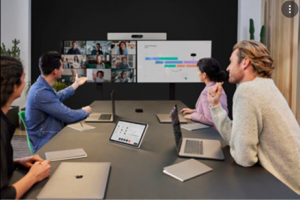
One major challenge of supporting a hybrid approach to working, is the increase in costs involved. This can extend to a full workspace makeover, but at the minimum it will involve software, particularly as it’s used for virtual team meetings, collaboration, and project management… And despite their dominance, there are options that are alternatives to MS Teams and zoom, and some that work with them. It’s a matter of making it fit your organisation…
And it’s not straightforward – shifting to hybrid was still only for innovators even a few years ago. Now, we’re all doing it, and it’s an opportunity to get your systems right, or be left in the wash of more agile businesses.
An insightful assessment of how organisations should approach hybrid work arrangements appeared in Harvard Business Review – How to Do Hybrid Right.
Once in a lifetime
Author Lynda Gratton says that to make this transition successfully, organisations will need to design hybrid work arrangements “…with individual human concerns in mind, not just institutional ones”, and that this requires companies to look at it from four different perspectives:
- jobs and tasks;
- employee preferences;
- projects and workflows;
- inclusion and fairness.
That’s a lot to factor in!
A new AFR article says that a common issue with hybrid model for many (smaller) businesses is that they’ve launched into remote management of projects and teams using expensive software originally designed for enterprise businesses.
To be more cost-effective and people-effective, businesses should now be reviewing their applications, finding out what’s really needed, and implementing the best solution/s.
The article quotes ‘Employees are ready for hybrid work, are you?’ (Cisco study of 1000 Australian employees), which says that while businesses are investing heavily, it’s a work in progress for many.
Of the study respondents:
-
on the plus side:
-
63% believe the quality of work has improved as a result of hybrid work;
-
80% feel their role can now be performed just as successfully remotely as in the office.
-
-
on the downside:
-
only 26% think their company is very prepared for a hybrid work future.
-
Software platforms
Chief people officer Sally Park at Biza.io saw that the post-lockdown reboot brought a mix of staff preferences re WFH / office base. Biza/io is an “open Banking, data storage, banking and telecommunications” software-as-a-service platform with head office in Brisbane and staff sprinkled around the country.
They believed that:
- it wasn’t sustainable for their team to carry on working as previously;
- they had to invest in the infrastructure to enable it;
- with the right tech, their staff could be just as productive working from home as they would be in the office, without a negative impact on team effectiveness or performance.
With the importance of collaboration to their business, they set out to address the notion based on pre-pandemic practice that collaboration must be in person, with that sense of compulsion that all hands must be in at the office.
They implemented LucidSpark (reviewed here on PCMag) to support their brainstorming. LucidSpark provides a multiuser virtual whiteboard and other tools, and they believed it would be a better solution than all staff Zooming into a meeting room with a whiteboard. (A collaboration tool alternative, which gets an even better review in PCMag, is miro).
Park suggests that businesses will get the most from staff in the office or at home by:
- being responsive and open to change;
- encouraging staff to find better ways of working, and
- letting that guide how they adapt the business.
Meetings
Team meetings are a bigger issue; it’s not just about the virtual platform software. Biza.io used to hold a whole-of-company stand-up meeting every morning. But as the business grew, Park received feedback that once team leaders covered what their team was working on, they felt idle and inefficient during the rest of the meeting. They now hold three different meetings:
-
A management-led state of play meeting for all staff at the start of the week, reviewing the prior week and breaking down the coming week.
-
Daily team leader stand-ups.
-
At the end of the week, an optional close-of-play meeting on a topic of broad interest ,that anyone in the company can present.
Time to take stock
The AFR article quotes Cassandie Tozer, head of P&C at Stockspot, as advising businesses wanting a successful hybrid work environment to use tech solutions that are shared and ‘instant’, as contrasted with having multiple people transposing notes and content across programs, which raises issues of efficiency, version control, and other challenges (Stockspot is a Sydney-based online investment adviser and fund manager).
And Cassandra Cadorin, of Candid Marketing, suggests that a useful review process will include:
-
-
Asking the whole team from juniors to managers what they need to get the job done.
-
Questioning any use of overlapping tools.
-
Removing software that isn’t used by 90% of the team.
-
Ultimately, taking on a review of this nature will streamline how you support your teams and clients, and manage your projects and workflows in the new hybrid world of work.
As Lynda Gratton says, it’s now a once in a lifetime opportunity – which pretty much makes it an imperative. One that we recommend!
At Atwork, we have a special interest in supporting clients on setting up for the Future of Work … you’re welcome to get in touch to discuss how it can be handled in your workplace.
Paul
